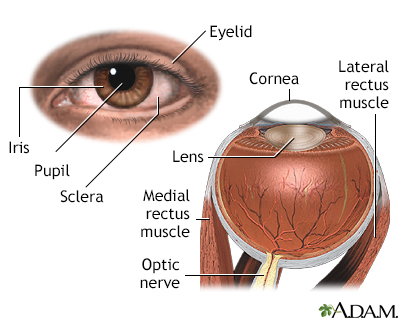Eye burning - itching and discharge
 Print-Friendly
Print-Friendly
Itching - burning eyes; Burning eyes
Eye burning with discharge is burning, itching, or drainage from the eye of any substance other than tears.
I Would Like to Learn About:
Causes
Causes may include:
- Allergies, including seasonal allergies or hay fever
- Infections, bacterial or viral including COVID-19 (conjunctivitis or pink eye)
- Chemical irritants (such as chlorine in a swimming pool or makeup)
- Dry eyes
- Irritants in the air (cigarette smoke or smog)
Home Care
Apply cool compresses to soothe itching.
Apply warm compress to soften eye crusts if they have formed. Washing the eyelids with baby shampoo on a cotton applicator can also help remove crusts.
Using artificial tears 4 to 6 times a day can be helpful for almost all causes of burning and irritation, especially dry eyes.
If you have allergies, try to avoid the cause (pets, grasses, cosmetics) as much as possible. Your health care provider may give you antihistamine eye drops to help with allergies.
Pink eye or viral conjunctivitis causes a red or bloodshot eye and excessive tearing. It may be highly contagious for the first few days. The infection will run its course in about 10 days. If you suspect pink eye:
- Wash your hands often
- Avoid touching the unaffected eye
When to Contact a Medical Professional
Contact your provider if:
- The discharge is thick, greenish, or resembles pus. (This may be from bacterial conjunctivitis.)
- You have excessive eye pain or sensitivity to light.
- Your vision is decreased.
- You have increased swelling in the eyelids.
What to Expect at Your Office Visit
Your provider will get a medical history and will perform a physical exam.
Questions you may be asked include:
- What does the eye drainage look like?
- When did the problem start?
- Is it in one eye or both eyes?
- Is your vision affected?
- Are you sensitive to light?
- Does anyone else at home or work have a similar problem?
- Have you been in contact with anyone who may have COVID-19?
- Do you have any new pets, linens, or carpets, or are you using different laundry soap?
- Do you also have a head cold or sore throat?
- What treatments have you tried so far?
The physical exam may include a check-up of your:
- Cornea
- Conjunctiva
- Eyelids
- Eye motion
- Pupils reaction to light
- Vision
Depending on the cause of the problem, your provider may recommend treatments such as:
- Lubricating eye drops for dry eyes
- Antihistamine eye drops for allergies
- Antiviral drops or ointments for certain viral infections such as herpes
- Antibiotic eye drops for bacterial conjunctivitis
Follow your provider's instructions exactly. With treatment, you should gradually improve. You should be back to normal in 1 to 2 weeks unless the problem is a chronic one like dry eyes.
If your provider suspects that your eye problem may be due to COVID-19, you may need to get tested.
Related Information
References
Cioffi GA, Liebmann JM. Diseases of the visual system. In: Goldman L, Cooney KA, eds. Goldman-Cecil Medicine. 27th ed. Philadelphia, PA: Elsevier; 2024:chap 391.
Dupre AA, Vojta LR. Red and painful eye. In: Walls RM, ed. Rosen's Emergency Medicine: Concepts and Clinical Practice. 10th ed. Philadelphia, PA: Elsevier; 2023:chap 18.
Rubenstein JB, Patel P. Allergic conjunctivitis. In: Yanoff M, Duker JS, eds. Ophthalmology. 6th ed. Philadelphia, PA: Elsevier; 2023:chap 4.7.
Rubenstein JB, Kelly E. Infectious conjunctivitis. In: Yanoff M, Duker JS, eds. Ophthalmology. 6th ed. Philadelphia, PA: Elsevier; 2023:chap 4.6.
Urmi UL, Willcox MD, Islam S, Kuppusamy R, Vijay AK. Ocular signs and symptoms of monkeypox virus infection, and possible role of the eye in transmission of the virus. Cont Lens Anterior Eye. 2023;46(2):101808. PMID: 36585302 pubmed.ncbi.nlm.nih.gov/36585302/.






